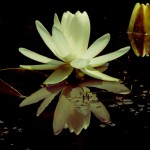“It is more important to have beauty in one’s equations
than to have them fit experiment.” –Paul Dirac.
There is a general notion that “beauty” is something that belongs to the arts and humanities and has more or less been banished from science. Yet, in the last hundred years, many prominent artists and humanists* have banished beauty from their consideration (e.g. the Dadist, Fluxus, and much of the Postmodern) and many prominent scientists and mathematicians have in their way proclaimed beauty as an inspiration and guide to scientific discovery.
The theory of beauty (aesthetics) proposed by twentieth century humanists tends to go from muddy to muddled. On the other hand, a scientist like Werner Heisenberg, in his essay “The Meaning of Beauty in the Exact Sciences,” gives a straight forward definition of beauty as “the proper proportion of the parts to the whole, and to each other.” Now the humanist might complain that this is overly simplistic, but from Aristotle to the present the notion of the integrity and proportionality of the parts to the whole has been a steady guide for artists, craftspeople, scientists and engineers.
In general, one will find a particular scientific theory more elegant than another by the greater diversity of phenomena that it can unify. The progress of science is always in this direction. Prior to Newton, one would not have suspected that the rising of a balloon and the falling of an apple were examples of the same phenomena: gravity. Prior to Maxwell and Faraday the scientists exploring magnets and those exploring static electricity did not suspect that the phenomena they were exploring would turn out to be different aspects of the same thing. Among the other great unifications are Darwin’s discovery of an underlying principle that unifies the diversity of living species and Einstein’s unification of space and time, and matter and energy. In our own time, the goal of theoretical physics is guided by the belief in a final unifying theory, a theory of everything that will harmonize quantum mechanics and general relativity and gravity with the other fundamental forces.
In addition to the idea of unity in variety, Heisenberg’s definition also speaks of proper proportion as being essential to beauty. Proportionality refers to ratios, and by extension to that which is rational. Thus the fundamental faith of science, that the world is ultimately rational, is an extension of this principle. The original of the idea that beauty has to do with proper proportion may have come from Pythagoras’ discovery of the mathematical relationships of musical tones. Another prominent example is the ancient Greek ideal of the golden mean, a ratio that has had a great influence on art and architecture.
The humanist again might be quick to complain that such examples as music and the golden mean are exceptions, that in the real world there is little basis for the idea that beauty refers to correct proportions. As an example, most people would say that a butterfly is more beautiful than a human louse. But on what basis could one say that a butterfly is more properly proportioned than a human louse? We associate butterflies with summer days and flowers, we associate the louse with parasitism and an itchy head. Does not the beauty we attribute to the butterfly really come from these associations, which in the end are quite subjective? And, of course, there is also the butterfly’s colorfulness. Pleasant associations and colorfulness are attributes of our common understanding of beauty – and one could argue that they are more central to it than the idea of proportionality. So can one justify the aesthetic ideal of proportionality?
As an undergraduate student, I took an entomology class from a professor who was a renowned authority on the human louse. He would get rhapsodic when showing slides of the louse’s anatomy and would occasionally say how beautiful the louse was. My fellow students would roll their eyes at this, but the louse’s internal organs are wonderfully proportioned to enhance its ability to survive its particular lifestyle. All living creatures are wonderfully proportioned in this sense – they are all beautiful in their own way. It takes a certain kind of detachment, however, to find beauty in a louse; indeed, it takes the kind of detachment required of a good scientist.
One of our most common uses of the word beauty is to refer to attributes that we find in other people, attributes that make others loveable to us. This connection of love and beauty is nearly opposite the kind of detachment that finds beauty in the form of a louse. One of the reasons, I suspect, that the idea of beauty is so muddled is that we have one word carrying many different meanings.
We might ask: When a physicist speaks of the beauty of an equation and when a young man speaks of the beauty of a Playboy centerfold, is there anything at all that these two uses of the world “beauty” have in common? At the emotional level, both are experiencing a kind of delight. But in terms of the object that is generating this delight, there is little or no similarity. The experience of beauty always has two poles: the pole of the experiencer and the pole of the object experienced. Different people take delight in vastly different objects. This fact has often been used as evidence that beauty is purely a matter of taste.

But is this not an oversimplification? Calling beauty purely a matter of taste does little to explain the complex phenomenon of the experience of beauty. I suggested earlier that a simple equation that explains a great deal is more beautiful than a complex equation that doesn’t really explain much. An equations explanatory power is not a matter of personal taste. Not everyone experiences beauty in the contemplation of mathematical equations, but those who do can often provide solid reasoning for their judgment of the difference between the more and less beautiful equation. If beauty were merely a matter of taste, any such reasoning would be fatuous.
Albert Einstein wrote “The most beautiful thing we can experience is the mysterious. It is the source of all true art and science.” This would seem to be a very different idea of beauty than the one proposed by Heisenberg. I would suggest though, that it is a necessary addition. Not only every organism, but every workable machine fulfills the requirement of Heisenberg’s definition of beauty – every good machine requires a proportionality of its parts and an integration of all the parts into a functioning whole. As with the case of living creatures, every successful machine also has its beauty.
But is there not something more to the beauty of a great work of art or to the works of nature, than this simple beauty of the machine? I would suggest that the difference is that a machine is not mysterious – there is always someone, hopefully the repairperson, who understands it fully. A great work of art is never fully understood, not even by the person who creates it. There have been thousands of articles written about Shakespeare’s Hamlet, and thousands more will undoubtedly be written in the future. Hamlet the character and Hamlet the play are filled with ambiguities.
Ambiguity is the life blood of a work of art. It is what keeps us coming back. Compare a crossword puzzle to a good poem. A crossword puzzle can be incredibly engaging and enjoyable to work on, but the moment the last box is completed, the value of the puzzle plummets to nothing. When finished, a crossword puzzle is utterly without ambiguity. A good work of art, through its ambiguities, makes sure that we can never fill in the last box. One can gaze at the Mona Lisa’s smile for ages, but you still cannot be completely sure what it conveys.
As ambiguity is to art, mystery is to Nature. For a few hundred years now, science has penetrated the layers of Nature’s mystery, but as each layer is penetrated a new layer is discovered. And this is not likely to end. Even if physicists should complete the quest for a final theory of physics, it has become increasingly clear that the theory will not answer the question of why and how the universe came to have the properties described by that theory. Like the Mona Lisa’s smile, Nature’s mystery refuses final resolution.
From the point of view of mystery, we can see that Heisenberg’s definition of beauty may be more a definition of value in general than a correct definition of beauty. Integrity and proportionality, wholeness and rationality, applies equally to the good, the true and the beautiful; the role of mystery, however, is quite different in each. A good machine or good legal system seeks to banish ambiguity; a true principle or theory acknowledges the presence of mystery, but seeks to penetrate it as far as possible. The beautiful object or idea celebrates the mysterious and invites contemplate of it.
 The truth of science plays a dual role in relation to other values. One the one side, it is eminently practical and its discoveries are the stock-in-trade of the engineer, who turns these discoveries into a society’s economic goods. But on the other side, its discoveries expand our sense of the world we live in, revealing its incredible diversity and the connections that hold this great diversity together — in short, revealing its beauty. Defined as Heisenberg defined it, it is not difficult to see how beauty can lead us to truth, and how truth can lead to beauty.
The truth of science plays a dual role in relation to other values. One the one side, it is eminently practical and its discoveries are the stock-in-trade of the engineer, who turns these discoveries into a society’s economic goods. But on the other side, its discoveries expand our sense of the world we live in, revealing its incredible diversity and the connections that hold this great diversity together — in short, revealing its beauty. Defined as Heisenberg defined it, it is not difficult to see how beauty can lead us to truth, and how truth can lead to beauty.
Connecting the world of ideas and the world of the senses, the physicist Murray Gell-Mann said at a Noble Prize banquet in his honor, “The beauty of the basic laws of natural science, as revealed in the study of particles and of the cosmos, is allied to the litheness of a merganser diving in a pure Swedish lake, or the grace of a dolphin leaving shining trails at night in the Gulf of California.” To this, I’ll say Amen! and leave it at that.
Subscribe to The Spiritual Naturalist Society
Learn about Membership in the Spiritual Naturalist Society
__________
The Spiritual Naturalist Society works to spread awareness of spiritual naturalism as a way of life, develop its thought and practice, and help bring together like-minded practitioners in fellowship.
__________
Written by Thomas Schenk.
__________
*Editor’s note: Schenk here, has stated that he means ‘humanist’ in the sense of scholars in the humanities, and not referring to the modern secular humanist movement.


















